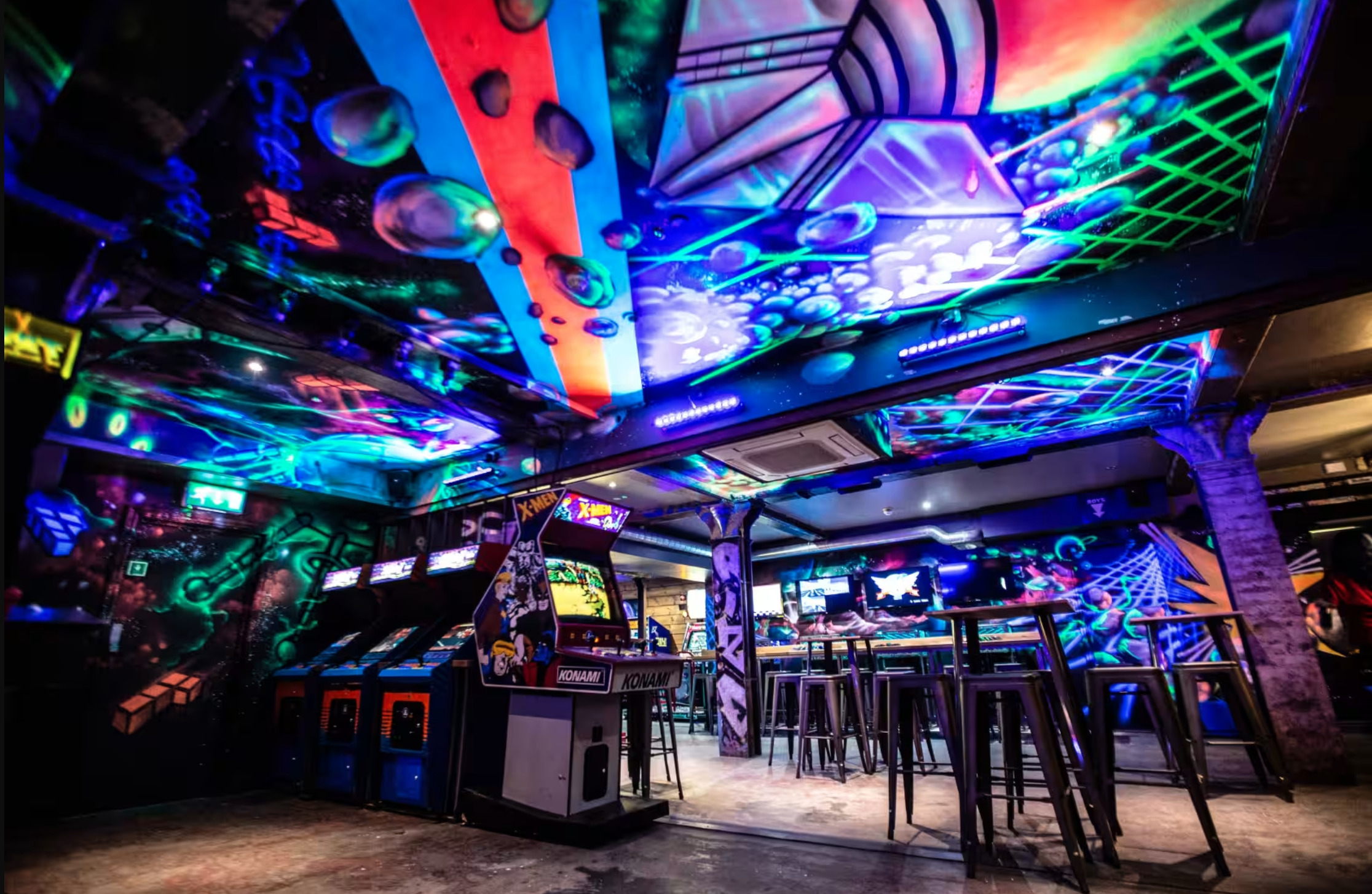A Global Trend Redefining How We Play, Socialise, and Compete
Competitive socialising is one of the most exciting trends reshaping the leisure and entertainment landscape. Blending fun, games, and social interaction, it offers a unique way for people to gather, compete, and bond in a casual, often lively setting.
Whether it’s playing darts with friends in a bar, competing in mini-golf over cocktails, or hitting the ping-pong table in a club-like atmosphere, competitive socialising isredefinesow we spend our leisure time.
But what exactly is competitive socialising, where did it originate, and who is it best suited for? In this briefing note, we’ll explore the rise of this trend, the different types of experiences it encompasses, and some of the best examples worldwide.
What is Competitive Socialising?
Competitive socialising refers to experiences that combine competitive games with social environments. These experiences typically take place in vibrant, interactive spaces where people can engage in friendly competition while enjoying food, drinks, and music.
Unlike traditional competitive sports, the focus of competitive socialising is on having fun rather than mastering a game. It’s about bringing people together in informal settings where everyone, regardless of skill level, can participate and enjoy.
Popular games like darts, mini-golf, bowling, and even ping pong are reimagined in immersive environments, often enhanced with technology to track scores and add an extra layer of excitement.
Where Did Competitive Socialising Originate?
Competitive socialising has its roots in traditional pub games like darts, pool, and foosball, which were popular in bars and social spaces throughout the UK and Europe.
However, the modern version of competitive socialising, which combines these activities with a more **immersive and technologically advanced setting**, began to emerge in the early 2010s.
London is often credited as the birthplace of this modern competitive socialising movement. Venues such as Flight Club (founded in 2015) and Bounce (founded in 2012) reinvented classic games like darts and ping pong, bringing them into dynamic social spaces with advanced scoring systems, great food, and high-energy atmospheres. These experiences struck a chord with millennials and young professionals looking for alternatives to standard bar or club nights.
Since then, the trend has spread globally, with new venues popping up in major cities worldwide, creating an exciting fusion of entertainment, competition, and social interaction.
Who is Competitive Socialising Best For?
Competitive socialising appeals to a wide range of demographics, but it has been particularly popular with the following groups:
- Millennials and Gen Z: These groups crave unique, memorable experiences that go beyond the traditional bar scene. Competitive socialising offers them an engaging, interactive way to socialise with friends or colleagues, often in vibrant, Instagram-worthy venues.
- Corporate Teams and Work Groups: Many companies use competitive socialising venues for **team-building activities**. The mix of light-hearted competition and social interaction is ideal for fostering collaboration and bonding outside the office.
- Groups Celebrating Special Occasions: Whether it’s a birthday party, a stag/hen/bachelor/bachelorette event, or a casual gathering, competitive socialising venues provide a unique way to celebrate with games, drinks, and fun in a lively setting.
- Couples and Families: Competitive socialising venues offer activities that are engaging for couples on dates or families looking for casual entertainment. Many venues are family-friendly during the day and transition to adult-oriented environments in the evening.
Types of Competitive Socialising
There’s a broad range of games and activities that fall under the umbrella of competitive socialising. Each of these experiences takes a traditional activity and transforms it into a social, game-enhanced event.
1. Social Darts
Darts has long been a staple of British pubs, but modern competitive socialising venues have elevated the game with technology. Automatic scoring, interactive screens, and a variety of game modes make darts more accessible and engaging for casual players.
Best Example: Flight Club, London, UK
Known as the pioneer of social darts, Flight Club combines automatic scoring technology with multiplayer game modes, creating an engaging and fast-paced environment. Its stylish décor, competitive games, and group-friendly atmosphere make it a hit for corporate events and parties.
2. Ping Pong
Ping pong, or table tennis, has seen a resurgence thanks to venues that pair the classic game with trendy bar settings. These spaces often feature live DJs, high-tech scoreboards, and themed events.
Best Example: Bounce, London, UK
Bounce turned ping pong into a social phenomenon. With its electric atmosphere, neon lights, and multiple ping pong tables, Bounce hosts lively events where groups of friends can compete while enjoying drinks and music. The venue even offers “Wonderball,” an interactive digital version of ping pong that projects animations onto the table.
3. Mini-Golf
Mini-golf is another leisure activity that’s been reimagined for the competitive socialising crowd. These venues combine elaborate, themed courses with bars and restaurants, making mini-golf a central part of a fun night out.
Best Example: Swingers, London, UK
Swingers combines mini-golf with a high-end bar and street food market. The two London locations feature creative courses inspired by seaside settings, and the vibrant atmosphere is perfect for group outings. Cocktails and gourmet street food complete the experience, making it a hotspot for competitive socialising in the capital.
4. Bowling
Traditional bowling alleys have been reimagined with immersive lighting, music, and digital enhancements to attract a younger, social crowd. Bowling lanes in these venues are designed for group gatherings, where drinks and food are as important as the game itself.
Best Example: All Star Lanes, UK
All Star Lanes offers boutique bowling experiences with a luxury twist. With stylish interiors, classic American food, and premium cocktails, it’s a go-to venue for those looking to enjoy bowling in a sophisticated, social setting.
5. Shuffleboard
Shuffleboard, a game traditionally associated with cruise ships, has been reimagined as a cool, casual game for social groups in trendy bars and clubs.
Best Example: Electric Shuffle, London, UK
Electric Shuffle brings shuffleboard into the digital age with automatic scoring and dynamic games designed to engage groups. It features a variety of multiplayer game modes and combines the competitive thrill of shuffleboard with a fun, party-like atmosphere.
6. Axe Throwing
Axe throwing has gained popularity as a unique competitive socialising activity. It offers participants the thrill of throwing axes at targets in a safe, controlled environment, often accompanied by drinks and food.
Best Example: Whistle Punks, London, UK
Whistle Punks is one of the leading axe-throwing venues in the UK, providing an exciting experience where players compete to hit targets and score points. The venue offers expert coaching and is perfect for team-building events or adventurous nights out with friends.
7. VR and Arcade Bars
Virtual reality (VR) and arcade bars combine gaming with competitive socialising. These venues often feature retro arcade machines, VR headsets, or interactive video games where players can compete head-to-head.
Best Example: NQ64, Manchester, UK
NQ64 is a retro arcade bar where guests can play classic arcade games and vintage consoles while enjoying craft beers and cocktails. The venue combines nostalgia with a modern social environment, making it a popular spot for gamers and social groups.
Best Examples of Competitive Socialising Worldwide
Competitive socialising has quickly spread beyond the UK, with notable venues around the world offering a similar mix of games, social interaction, and immersive environments.
SPiN, New York, USA:
A trendy ping pong social club that blends music, art, and high-energy competitions in a nightclub-like setting. SPiN has locations across the US and is popular for group events and parties.
Puttshack, Chicago, USA:
Known for its cutting-edge mini-golf technology, Puttshack offers high-tech, competitive mini-golf courses combined with stylish bars and restaurants.
Two Bit Circus, Los Angeles, USA:
A modern “micro-amusement park” offering a blend of VR, interactive games, and immersive storytelling experiences, perfect for those looking for a tech-driven twist on competitive socialising.
Conclusion: A Global Trend with Local Appeal
Competitive socialising has revolutionised the way people connect and play, offering a blend of lighthearted competition, social interaction, and immersive entertainment. Whether it’s throwing axes, playing ping pong, or navigating a mini-golf course, these venues provide engaging, dynamic experiences that are perfect for group outings, corporate events, or casual get-togethers.
With its roots in the UK, competitive socialising has now expanded globally, transforming leisure and entertainment with its innovative approach to social games. As the trend continues to grow, expect more creative and interactive venues to emerge, offering exciting new ways for people to socialise, compete, and have fun.
Related Content

Impact Assessment: Phantom Peak, Canada Water
Phantom Peak, an immersive, open-world experience located in Surrey Quays, London, has played a role in revitalizing the local area by drawing increased foot traffic, boosting local spending, and contributing to the regeneration of underused spaces. The attraction’s innovative, interactive model has benefited local businesses, residents, and the broader economy.



